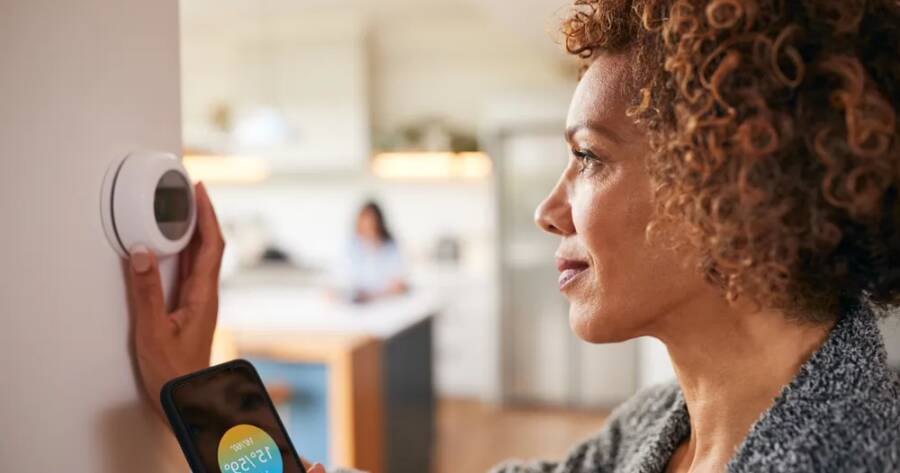Cutting energy waste doesn’t just lower your utility bills—it also helps reduce your environmental impact. Small adjustments, like sealing drafts, upgrading to LED bulbs, and using smart thermostats, can make your home more efficient without major renovations. Whether you want to save money or live a more eco-friendly lifestyle, simple upgrades and habit changes can go a long way. With the right strategies, you can create a comfortable home that conserves energy and keeps costs down year-round.
Upgrade to LED Light Bulbs
Switching to LED light bulbs is one of the easiest and most cost-effective ways to improve energy efficiency. LEDs use up to 75% less energy and last significantly longer than traditional incandescent bulbs. While the initial cost of LEDs may be higher, they pay for themselves in energy savings and reduced replacement frequency. Look for ENERGY STAR®-certified bulbs for the best efficiency and brightness.
Smart LED bulbs take energy savings even further by allowing you to set timers or adjust brightness remotely. Replacing outdated bulbs with energy-efficient options helps lower electricity usage while keeping your home well-lit and inviting.
Install a Smart Thermostat
A smart thermostat helps regulate heating and cooling, reducing unnecessary energy waste. These devices learn your schedule and automatically adjust temperatures based on when you’re home or away. Lowering the temperature by 7-10°F for eight hours a day can save up to 10% on heating and cooling costs.
Many smart thermostats also have app controls, allowing you to adjust settings remotely. Some models even provide energy reports to help you track and optimize usage. Pairing a smart thermostat with ceiling fans and proper insulation further enhances efficiency. Keeping your home at an optimal temperature without excessive energy use makes a significant impact on both your comfort and monthly bills.
Seal Drafts and Improve Insulation
Air leaks around windows, doors, and vents can lead to significant energy loss, forcing your HVAC system to work harder. Sealing these gaps with weatherstripping, caulk, or door sweeps helps maintain indoor temperatures and reduces heating and cooling costs. For an extra layer of efficiency, consider adding insulation to your attic, walls, and floors, especially if you live in an older home.
Proper insulation prevents heat loss in winter and keeps cool air from escaping in summer. A simple DIY draft test using a candle near doors and windows can reveal where leaks exist. Investing in better insulation and sealing air leaks leads to long-term energy savings and increased comfort.
Use Energy-Efficient Appliances
Old, inefficient appliances can consume large amounts of electricity. Upgrading to ENERGY STAR®-certified refrigerators, dishwashers, and washing machines can cut energy consumption significantly. Front-loading washing machines use less water and energy than top-loading models, while energy-efficient dishwashers reduce both electricity and water waste.
Even smaller changes, like using a toaster oven instead of a full-size oven for small meals, can make a difference. If replacing appliances isn’t an option, using them wisely—like running full loads in dishwashers and washing machines, air-drying clothes, and setting refrigerators to optimal temperatures—can still improve efficiency and lower energy costs.
Switch to Smart Power Strips
Many electronics continue to use power even when turned off—this is known as phantom energy drain. Smart power strips detect when devices are in standby mode and automatically cut power to prevent unnecessary energy waste. These are especially useful for home offices and entertainment centers, where multiple devices like TVs, gaming consoles, and chargers may be plugged in at once.
Simply plugging appliances into a smart strip or unplugging them when not in use can lead to noticeable energy savings. With a simple switch, you can prevent wasted electricity and lower your utility bills effortlessly.
Optimize Water Usage and Heating
Water heating accounts for a significant portion of energy use, so small changes can lead to big savings. Lowering your water heater temperature to 120°F, using low-flow showerheads and faucet aerators, and washing clothes in cold water all help reduce energy consumption. Taking shorter showers, fixing leaks, and installing insulated water heater blankets can further improve efficiency.
If you’re ready for an upgrade, consider a tankless water heater, which heats water on demand instead of continuously maintaining a hot water supply. By making smart choices with water use and heating, you can save energy while maintaining daily comfort.
Small Changes, Big Energy Savings
Making your home more energy-efficient doesn’t require expensive upgrades or drastic lifestyle changes. Simple adjustments—like switching to LED bulbs, sealing drafts, using smart power strips, and optimizing water use—can lead to noticeable savings on utility bills while reducing your environmental impact.
Over time, these small changes add up, making your home more comfortable, cost-effective, and sustainable. By taking a few smart steps today, you can enjoy a greener, more energy-efficient home for years to come.

